Leif Erikson
Leif Erikson, Leiv Eiriksson or Leif Ericson[note 1] (c. 970 – c. 1020) was a Norse explorer from Iceland.[6] He is thought to be the first known European to have set foot on continental North America (excluding Greenland), approximately half a millennium before Christopher Columbus.[7][8] According to the sagas of Icelanders, he established a Norse settlement at Vinland, which is usually interpreted as being coastal North America. There is ongoing speculation that the settlement made by Leif and his crew corresponds to the remains of a Norse settlement found in Newfoundland, Canada, called L'Anse aux Meadows and which was occupied c. 1000. Later archaeological evidence suggests that Vinland may have been the areas around the Gulf of St. Lawrence and that the L'Anse aux Meadows site was a ship repair station.
Leif Erikson | |
|---|---|
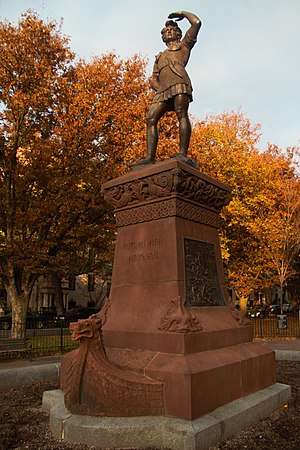 The oldest public statue of Leif, placed in Boston in 1887. | |
| Born | c. 970 |
| Died | c. 1020 |
| Nationality | Norse: Icelandic–Norwegian |
| Occupation | Explorer |
| Known for | First European in Vinland (part of North America; possibly Newfoundland) |
| Partner(s) | Thorgunna (c. 999) |
| Children | Thorgils, Thorkell |
| Relatives | Erik the Red (father), Þjóðhildur (mother), Thorvald, Thorstein and Freydís (siblings) |
Leif was the son of Erik the Red, the founder of the first Norse settlement in Greenland and of Thjodhild (Þjóðhildur), both of Norwegian origin. His place of birth is not known,[9] but he is assumed to have been born in Iceland, which had recently been colonized by Norsemen mainly from Norway.[6][10][11] He grew up in the family estate Brattahlíð in the Eastern Settlement in Greenland. Leif had two known sons: Thorgils, born to noblewoman Thorgunna in the Hebrides; and Thorkell, who succeeded him as chieftain of the Greenland settlement.
Early life
Leif was the son of Erik the Red and his wife Thjodhild, and the grandson of Thorvald Ásvaldsson, and distant relative of Naddodd,[12] who discovered Iceland.[13] He was a Viking in the early days. His year of birth is most often given as c. 970 or c. 980.[14] Though Leif's birthplace is not accounted for in the sagas,[15] it is likely he was born in Iceland,[6] where his parents met[14]—probably somewhere on the edge of Breiðafjörður, and possibly at the farm Haukadal where Thjóðhild's family is said to have been based.[6] Leif had two brothers, whose names were Thorsteinn and Thorvaldr, and a sister, Freydís.[16]
Thorvald Asvaldsson was banished from Norway for manslaughter and went into exile in Iceland accompanied by young Erik. When Erik was banished from Iceland, he travelled further west to an area he named Greenland, where he established the first permanent settlement in 986.[15][17] Tyrker, one of Erik's thralls, had been specially trusted to keep in charge of Erik's children, as Leif later referred to him as his "foster father".[18]
Discovering Vinland
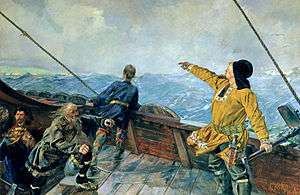
by Christian Krohg (1893)
Leif and his crew travelled from Greenland to Norway in 999. Blown off course to the Hebrides and staying for much of the summer, he arrived in Norway and became a hirdman of King Olaf Tryggvason. He also converted to Christianity and was given the mission of introducing the religion to Greenland.[15][19] The Saga of Erik the Red and the Saga of the Greenlanders, both thought to have been written around 1200,[20] contain different accounts of the voyages to Vinland.[21][22] The only two known strictly historical mentions of Vinland are found in the work of Adam of Bremen c. 1075 and in the Book of Icelanders compiled c. 1122 by Ari the Wise.[23] According to the Saga of Erik the Red, Leif apparently saw Vinland for the first time after being blown off course on his way to introduce Christianity to Greenland.[19]
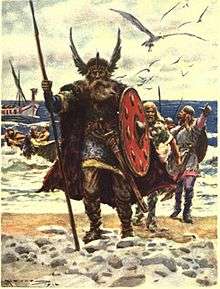
by Arthur C. Michael (1919)
According to a literal interpretation of Einar Haugen's translation of the two sagas in the book Voyages to Vinland, Leif was not the first European to discover America: he had heard the story of merchant Bjarni Herjólfsson who claimed to have sighted land to the west of Greenland after having been blown off course. Bjarni reportedly never made landfall there, however. Later, when travelling from Norway to Greenland, Leif was also blown off course, to a land that he did not expect to see, where he found "self-sown wheat fields and grapevines". He next rescued two men who were shipwrecked in this country and went back to Greenland and Christianised the people there.[24] Consequently, if this is to be trusted, Bjarni Herjólfsson was the first European to see America beyond Greenland, and the two unnamed shipwrecked men were the first people known to Europeans to have made landfall there.
Leif then approached Bjarni, purchased his ship, gathered a crew of thirty-five men, and mounted an expedition towards the land Bjarni had described.[25] His father Erik was set to join him but dropped out after he fell from his horse on his way to set sail, an incident he interpreted as a bad omen.[26] Leif followed Bjarni's route in reverse and landed first in a rocky and desolate place he named Helluland (Flat-Rock Land; possibly Baffin Island).[27] After venturing further by sea, he landed the second time in a forested place he named Markland (Forest Land; possibly near Cape Porcupine, Labrador).[27] After two more days at sea, he landed on an island to the north (possibly Belle Isle), and then returned to the mainland, going past a cape on the north side (perhaps Cape Bauld).[27] They sailed to the west of this and landed in a verdant area with a mild climate and plentiful supplies of salmon. As winter approached, he decided to encamp there and sent out parties to explore the country.[27] During one of these explorations, Tyrker discovered that the land was full of vines and grapes. Leif therefore named the land Vinland ('Wineland').[27][28] There, he and his crew built a small settlement, which was called Leifsbudir (Leif's Booths) by later visitors from Greenland.

After having wintered over in Vinland, Leif returned to Greenland in the spring with a cargo of grapes and timber.[25][29] On the return voyage, he rescued an Icelandic castaway and his crew, earning him the nickname "Leif the Lucky".[30]
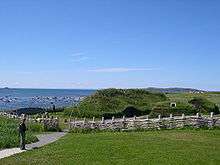
Research done in the early 1960s by Norwegian explorer Helge Ingstad and his wife, archaeologist Anne Stine Ingstad, identified a Norse site[31] located at the northern tip of Newfoundland. It has been suggested that this site, known as L'Anse aux Meadows, is Leifsbúðir. The Ingstads demonstrated that Norsemen had reached America about 500 years before Christopher Columbus.[32][33] Later archaeological evidence suggests that Vinland may have been the areas around the Gulf of St. Lawrence and that the L'Anse aux Meadows site was a ship repair station and waypoint for voyages there. That does not necessarily contradict the identification of L'Anse aux Meadows with Leifsbúðir[33][34] since the two sagas appear to describe Vinland as a wider region which included several settlements. The Saga of Erik the Red mentions two other settlements in Vinland: a settlement called Straumfjǫrðr, which lay beyond Kjalarnes promontory and the Wonderstrands, and one called Hóp, which was located even farther south.[35]
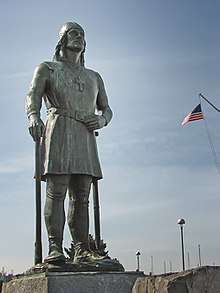
Personal life
Leif was described as a wise, considerate, and strong man of striking appearance.[36] During his stay in the Hebrides, he fell in love with a noblewoman, Thorgunna, who gave birth to their son Thorgils.[16] Thorgils was later sent to Leif in Greenland, but he did not become popular.[36]
After Leif's first trip to Vinland, he returned to the family estate of Brattahlíð in Greenland, and started preaching Christianity to the Greenlanders. His father Erik reacted coldly to the suggestion that he should abandon his religion, while his mother Thjóðhildr quickly became a Christian and built a church called Thjóðhild's Church.[37] Leif is last mentioned alive in 1019, and by 1025 he had passed on his chieftaincy of Eiríksfjǫrðr[15] to another son, Thorkell.[36][38] Nothing is mentioned about his death in the sagas—he probably died in Greenland some time between these dates.[36][39] Nothing further is known about his family beyond the succession of Thorkell as chieftain.[36]
Legacy
Norse and Medieval Europe
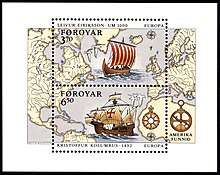
Leif's successful expedition in Vinland encouraged other Norsemen to also make the journey. The first apparent contact between the Norse and the indigenous people, who the Norse later referred to as skrælingjar, was made by his brother Thorvald, and resulted in hostilities and killing.[40] In the end there were no permanent Norse settlements in Vinland, although sporadic voyages at least to Markland for forages, timber and trade possibly lasted for centuries.[41][42] The casual tone of references to these areas may suggest that their discovery was not seen as particularly significant by contemporaries, or that it was assumed to be public knowledge, or both.[23] Knowledge of the Vinland journeys spread around medieval Europe although to what extent is unclear; writers made mention of remote lands to the west, and notably the medieval chronicler Adam of Bremen directly mentions Vinland (c.1075) based upon reports from the Danes.[note 2] It has been suggested that the knowledge of Vinland might have been maintained in European seaports in the 15th century, and that Christopher Columbus, who claimed in a letter to have visited Iceland in 1477, could have heard stories of it.[40]
Travels and commemoration
.jpg)
Stories of Leif's journey to North America had a profound effect on the identity and self-perception of later Nordic Americans and Nordic immigrants to the United States.[17] The first statue of Leif (by Anne Whitney)[43] was erected in Boston in 1887 at the instigation of Eben Norton Horsford, who was among those who believed that Vinland could have been located on the Charles River or Cape Cod;[17] not long after, another casting of Whitney's statue was erected in Milwaukee.[44] A statue was also erected in Chicago in 1901, having been originally commissioned for the 1893 World's Columbian Exposition to coincide with the arrival of the reconstructed Viking ship from Bergen, Norway.[17] Another work of art made for the 1893 World's Columbian Exposition, the painting Leiv Eiriksson oppdager Amerika by Christian Krohg, was in the possession of a Leif Erikson Memorial Association in Chicago before being given back to the National Gallery of Norway in 1900.[45]
For the centenary of the first official immigration of Norwegians to America, President Calvin Coolidge stated at the 1925 Minnesota State Fair, to a crowd of 100,000 people, that Leif had indeed been the first European to discover America.[17] Additional statues of him were erected at the Minnesota State Capitol in St. Paul in 1949, near Lake Superior in Duluth, Minnesota, in 1956, and in downtown Seattle.[17]
The Sagas do not give the exact date of Leif Erikson's landfall in America, but state only that it was in the fall of the year. At the suggestion of Christian A. Hoen, Edgerton, Wis., 9 October was settled upon, as that already was a historic date for Norwegians in America, the ship Restaurationen having arrived in New York Harbor on 9 October 1825[46][47] from Stavanger with the first organized party of Norwegian immigrants.
In 1924, a party of four consisting of a Swede, an Englishman, and two Americans attempted to emulate Erikson's voyage in an eponymous 40-foot vessel but were lost after reaching the west coast of Greenland.[48]:267
In 1929, the Wisconsin Legislature passed a bill to make 9 October "Leif Erikson Day" in the state.[46] In 1964, the United States Congress authorized and requested the president to proclaim 9 October of each year as "Leif Erikson Day".[17]
In 1930, a statue of Erikson was erected in the city center of Reykjavík, Iceland – currently situated in front of Hallgrímskirkja — as a gift from the United States to Iceland to commemorate the 1,000 year anniversary of Alþingi, the parliament of Iceland.[49]
In fiction
- Leif is the main character in two novels called Vinland the Good, and the 1928 film The Viking.
- Leif is one of the main characters in Guðmundur Kamban's novel Jeg ser et stort skønt Land (1936, transl. 1938 as I See A Wondrous Land).
- Leif is one of the main characters in Makoto Yukimura's manga Vinland Saga.
- In the video game Age of Empires II: Definitive Edition, Leif Erikson leads a Longship.
See also
- Alonso Sánchez, a Spanish navigator who purportedly visited the Americas before Columbus
- Jean Cousin, a French navigator with a similar claim
- Leif Erikson Awards
- Leif Ericson Millennium commemorative coins
Notes
- The patronym is Anglicized in various ways in the United States; according to one source, Leif Ericson is the most common rendering on the East Coast, while Leif Erikson is the most common rendering on the West Coast.[1] Erikson is the spelling widely used and recognized by many others.[2][3][4][5] Old Norse: Leifr Eiríksson; Icelandic: Leifur Eiríksson; Norwegian: Leiv Eiriksson
- Adam mentions Vinland (Winland) in Chapter 39 of Book IV of his Gesta: 'In addition, he [i.e., Sweyn Estridsson, king of Denmark (reigned 1047–1076)] named one more island in this ocean, discovered by many, which is called "Vinland", because vines grow wild there, making the best wine. For [that] crops [that are] not sown, abound there, we learn not from fanciful opinion but from the true account of the Danes.' Adam von Bremen (1917). Schmeidler, Bernhard (ed.). Hamburgische Kirchengeschichte [Hamburg's Church History] (in Latin and German). Hannover and Leipzig, Germany: Hahnsche. pp. 275–276.
References
- Leander, Kristine (2008). Norwegian Seattle. Arcadia Publishing. p. 63. ISBN 978-0-7385-5960-5.
- "Turning over a new Leif". Leif Erikson International Foundation. Retrieved 23 March 2014.
- Leif Erikson Issue. Smithsonian Institution. Retrieved 23 March 2014.
- "History". Sons of Norway. Retrieved 23 March 2014.
- Norwegian-American Studies, Volumes 1–3. Norwegian-American Historical Association. 1926.
- Sverrir Jakobsson (14 July 2001). "Vísindavefurinn: Var Leifur Eiríksson ekki Grænlendingur sem átti rætur að rekja til Íslands og Noregs?" [Was Leif Eiriksson not a Greenlander who had roots in Iceland and Norway?] (in Icelandic). Visindavefur.hi.is. Retrieved 16 February 2010.
- "Leif Erikson (11th century)". BBC. Retrieved 20 November 2011.
- "Why Do We Celebrate Columbus Day and Not Leif Erikson Day?". National Geographic. 11 October 2015. Retrieved 12 October 2015.
- Leiv Eriksson, Norsk biografisk leksikon
- Leif Eriksson – Encyclopædia Britannica, Inc., 2012. Retrieved 11 April 2012.
- books.google.is
- "Thorvald Asvaldsson | Mediander | Connects". Mediander. Archived from the original on 28 August 2017. Retrieved 26 October 2015.
- "The Discovery of Iceland". www.viking.no. Retrieved 26 October 2015.
- Sanderson, Jeanette. (2002) Explorers, Teaching Resources/Scholastic. p. 14. ISBN 0-439-25181-8.
- "Leiv Eiriksson". Store norske leksikon (in Norwegian). Retrieved 13 November 2011.
- Ingstad, Helge; Ingstad, Anne Stine (2000). The Viking discovery of America: the excavation of a Norse settlement in L'Anse aux Meadows, Newfoundland. Breakwater Books. p. 74. ISBN 978-1-55081-158-2.
- Dregni, Eric (2011). Vikings in the attic: in search of Nordic America. U of Minnesota Press. pp. 72–73. ISBN 978-0-8166-6744-4.
- Wiesner, Merry E.; Wiesner-Hanks, Merry E.; Wheeler, William Bruce; Doeringer, Franklin; Curtis, Kenneth R. (2011). Discovering the Global Past. Cengage Learning. p. 158. ISBN 978-1-111-34142-8.
- Somerville & McDonald, 2010, pp. 419–420.
- Lindkvist, Thomas (2003). "Early political organisation". In Helle, Knut (ed.). The Cambridge History of Scandinavia: Prehistory to 1520. Cambridge University Press. p. 212. ISBN 978-0-521-47299-9.
- Somerville & McDonald, 2010, p. 350.
- Short, 2010, p. 203.
- "Vinland History". National Museum of Natural History. Smithsonian Institution. Retrieved 23 November 2011.
- archive.org
- Short, 2010, pp. 203–204.
- Somerville & McDonald, 2010, p. 352.
- Wernick, Robert (1979). The Vikings. Alexandria, VA: Time-Life Books. pp. 149–151. ISBN 0-8094-2709-5.
- Kudeba, N. (19 April 2014). Chapter 5 – Norse Explorers from Erik the Red to Leif Erikson – Canadian Explorers. Retrieved from The History of Canada: "Archived copy". Archived from the original on 8 May 2014. Retrieved 22 April 2014.CS1 maint: archived copy as title (link)
- Somerville & McDonald, 2010, pp. 352–354.
- Somerville & McDonald, 2010, p. 354.
- "L'Anse aux Meadows". L'Anse aux Meadows National Historic Site of Canada. Parks Canada. 2018. Retrieved 21 December 2018.
Here [L'Anse aux Meadows] Norse expeditions sailed from Greenland, building a small encampment of timber-and-sod buildings …
- "Helge Ingstad". The Telegraph. 30 March 2001. Retrieved 20 November 2011.
- Short, 2010, p. 207.
- "Vinland Archeology". National Museum of Natural History. Smithsonian Institution. Retrieved 21 November 2011.
- "Vinland Sagas". National Museum of Natural History. Smithsonian Institution. Retrieved 21 November 2011.
- "Leif Eiriksson, "Leif the Lucky" (Leifr Eiríksson, nicknamed, Leifr hin heppni)". Great Unsolved Mysteries in Canadian History: Where is Vinland?. Retrieved 21 November 2011.
- Somerville & McDonald, 2010, p. 420.
- Seaver, Kirsten A. (1997). The frozen echo: Greenland and the exploration of North America, ca. A.D. 1000–1500. Stanford University Press. p. 62. ISBN 978-0-8047-3161-4.
- Hermannsson, Halldór (1936). "The problem of Wineland, Volume 1; Volume 25". Cornell university press. Cite journal requires
|journal=(help) - Short, 2010, pp. 203–206.
- Schledermann, Peter. (1996). Voices in Stone. A Personal Journey into the Arctic Past. Komatik Series no. 5. Calgary: The Arctic Institute of North America and the University of Calgary.
- Sutherland, Patricia. (2000). "The Norse and Native Norse Americans". In William W. Fitzhugh and Elisabeth I. Ward, eds., Vikings: The North Atlantic Saga, pp. 238–247. Washington, DC: The Smithsonian Institution.
- Forbes, Alan and Ralph M. Eastman, "Some Statues of Boston: Reproductions of some of the statues for which Boston is famous, with information concerning the personalities and events memorialized", State Street Trust Company, Boston MA 1946 and Forbes, Alan and Ralph M. Eastman, "Other Statues of Boston", State Street Trust Company, Boston MA 1947.
- Buck, Diane M; Palmer, Virginia A (1995). Outdoor Sculpture in Milwaukee: A Cultural and Historical Guidebook. Madison: The State Historical Society of Wisconsin. pp. 9–12. ISBN 978-0-87020-276-6.
- "Leiv Eiriksson oppdager Amerika". Store norske leksikon (in Norwegian). Oslo: Kunnskapsforlaget. Retrieved 2 December 2011.
- Hansen, Carl G. O. (1956). "Leif Erikson Comes to the Front". My Minneapolis. Retrieved 2 December 2011.
- Obama, Barack (7 October 2009). "Leif Erikson Day, 2009" (Press release). White House Office of the Press Secretary. Archived from the original on 24 January 2011. Retrieved 20 November 2011.
- Thomas, Lowell (1925). The First World Flight. Boston & New York: Houghton Mifflin Company.
- Helgason, Magnús Sveinn; Eliason, Matt; McMahon, Sara; Sigurþórsdóttir, Sunna Karen (2 November 2015). "Ten fascinating facts about the statue of Leifur Eiríksson". Icelandmag. Retrieved 16 June 2020.
Bibliography
- Short, William R. (2010). Icelanders in the Viking age: the people of the sagas. McFarland. ISBN 978-0-7864-4727-5.
- Somerville, Angus; McDonald, Andrew R. (2010). The Viking Age: A Reader. University of Toronto Press. ISBN 978-1-4426-0148-2.
External links
| Wikimedia Commons has media related to Leif Erikson. |
- Works about Leif Erikson at Open Library
- Works about Leif Erikson at WorldCat Identities